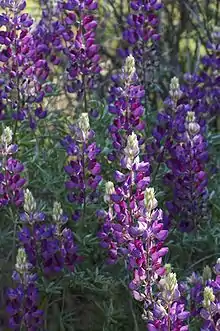| Lupinus albifrons | |
|---|---|
 | |
| Scientific classification | |
| Kingdom: | Plantae |
| Clade: | Tracheophytes |
| Clade: | Angiosperms |
| Clade: | Eudicots |
| Clade: | Rosids |
| Order: | Fabales |
| Family: | Fabaceae |
| Subfamily: | Faboideae |
| Genus: | Lupinus |
| Species: | L. albifrons |
| Binomial name | |
| Lupinus albifrons | |
Lupinus albifrons, silver lupine, white-leaf bush lupine, or evergreen lupine, is a species of lupine (lupin). It is native to California and Oregon, where it grows along the coast and in dry and open meadows, prairies and forest clearings. It is a member of several plant communities, including coastal sage scrub, chaparral, northern coastal scrub, foothill woodland, and yellow pine forest.
Description
Lupinus albifrons is a perennial shrub, taking up about 2 ft (0.61 m) of space and reaching 5 ft (1.5 m). It has a light blue to violet flower on 3–12 inches (7.6–30.5 cm) stalks. The leaves are silver with a feathery texture.[3] It grows in sandy to rocky places below 5,000 feet (1,500 m).[4]
Cultivation
This plant grows as a wildflower in the hills and valleys of California. It requires good drainage and needs little water once the roots are established.
Toxicity to livestock
The plant is deer-resistant due to the presence of the bitter-tasting alkaloid toxins anagyrine and lupinine.[5] Because of these toxins lupines can negatively affect livestock, causing birth defects and decreasing weight especially in young, inexperienced cattle.[5] When cows are under stress from lactating, especially in times of low forage availability, they will consume more lupine than usual.[5]
Mission blue butterfly
The federally endangered mission blue butterfly requires either Lupinus albifrons, Lupinus formosus and Lupinus variicolor, on which their larvae feed.[6] The butterfly becomes toxic itself when it feeds on the plant, leaving it with a bitter taste to deter predators.
Due to its potential danger to livestock, this lupine is removed from rangeland when possible, eliminating a crucial food plant from the butterfly's range.
Infraspecific taxa
Lupinus albifrons has six different varieties, four of which occur only in California, the other two occur in both California and Oregon:[7]
- Lupinus albifrons var. albifrons, silver lupine
- Lupinus albifrons var. collinus, silver lupine
- Lupinus albifrons var. douglasii, Douglas' silver lupine
- Lupinus albifrons var. eminens, silver lupine
- Lupinus albifrons var. flumineus, silver lupine.
- Lupinus albifrons var. hallii, also called Lupinus paynei, Payne's bush lupine. [8]
Photos


See also
References
- ↑ "NatureServe Explorer Lupinus albifrons". NatureServe Explorer Lupinus albifrons. Arlington Virginia, United States of America: NatureServe. 2022-06-03. NatureServe Element Code:PDFAB2B060. Retrieved 23 Jun 2022.
- ↑ Faber-Langendoen, D; Nichols, J; Master, L; Snow, K; Tomaino, A; Bittman, R; Hammerson, G; Heidel, B; Ramsay, L; Teucher, A; Young, B (2012). NatureServe Conservation Status Assessments: Methodology for Assigning Ranks (PDF) (Report). Arlington, Virginia, United States of America: NatureServe.
- ↑ "Silver Lupine, Lupinus albifrons". calscape.org. Retrieved 2021-12-30.
- ↑ "Lady Bird Johnson Wildflower Center - The University of Texas at Austin". www.wildflower.org. Retrieved 2021-12-30.
- 1 2 3 Effects of Experience and Lactation on Lupine Consumption by Cattle
- ↑ Essig Museum of Entomology
- ↑ Plant Profile, Silver Lupine, Natural Resources Conservation Service, U.S. Department of Agriculture
- ↑ https://www.calflora.org/app/taxon?crn=13568
External links
- Jepson Manual Treatment - Lupinus albifrons
- CalFlora - Lupinus albifrons
- Lady Bird Johnson Wildflower Center
- Golden Gate National Recreation Area
- Lupinus albifrons - Photo gallery
